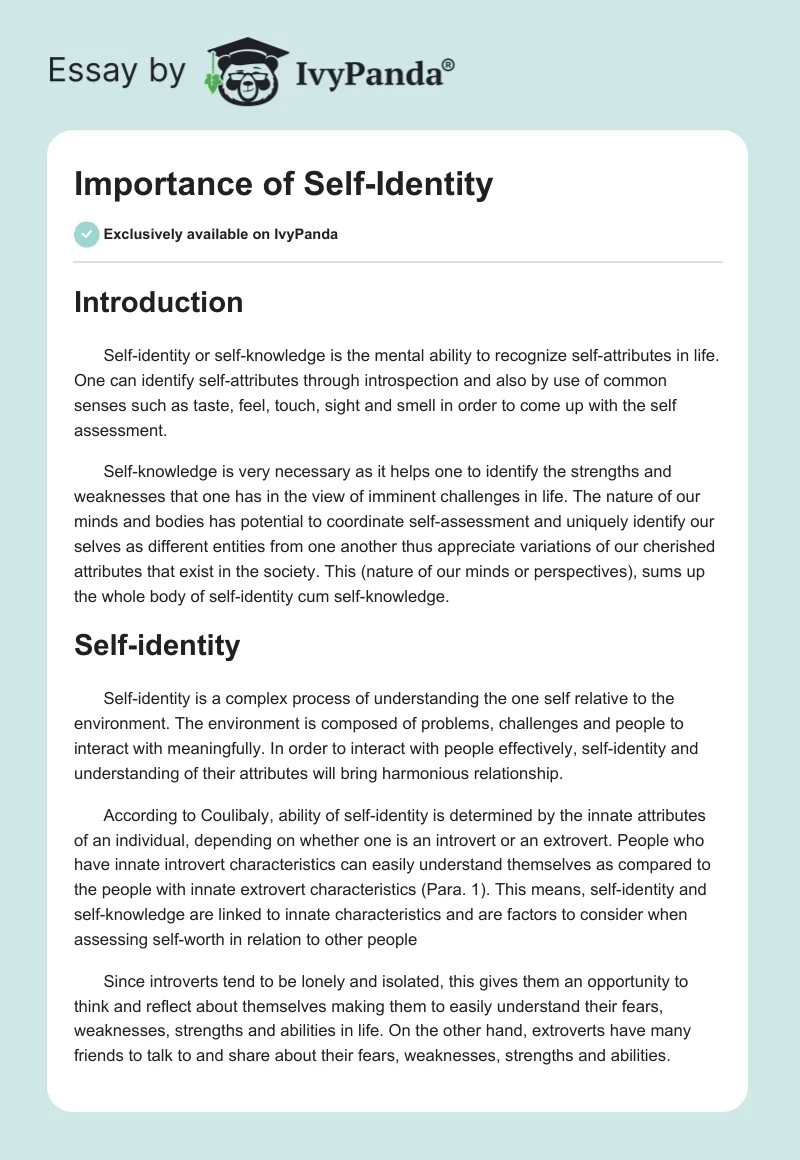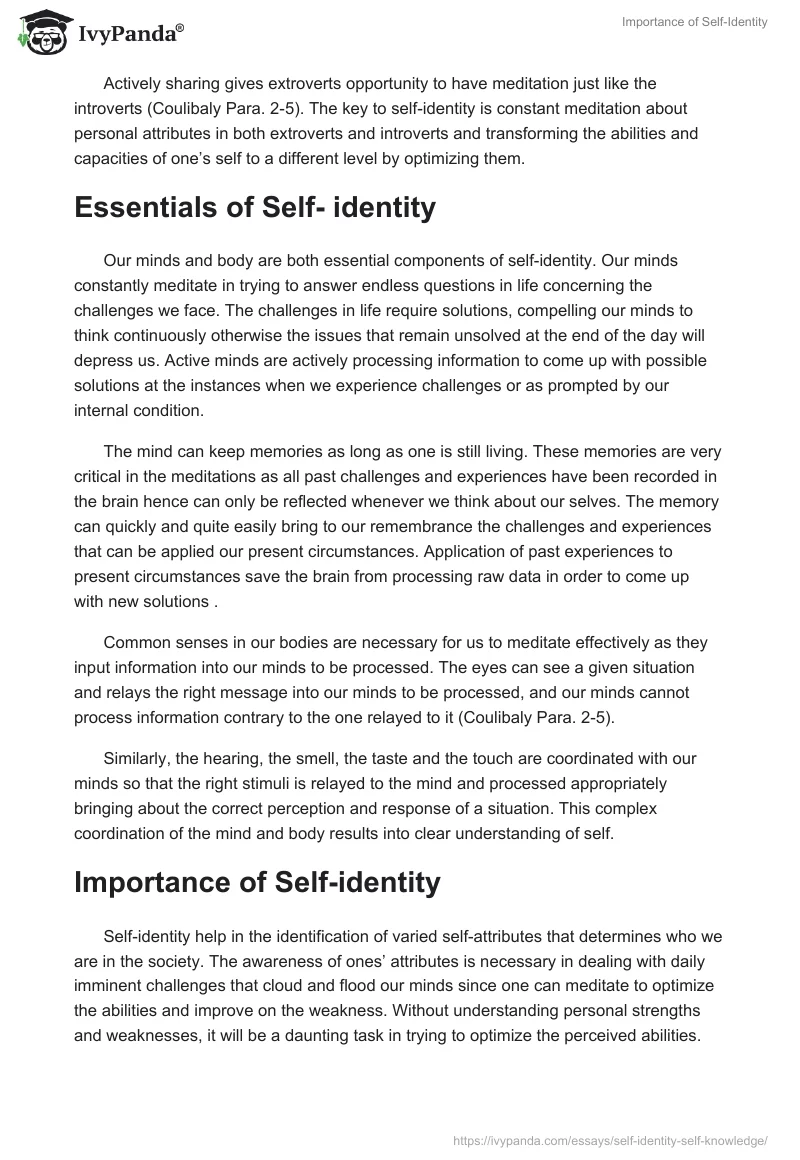Introduction
Self-identity or self-knowledge is the mental ability to recognize self-attributes in life. One can identify self-attributes through introspection and also by use of common senses such as taste, feel, touch, sight and smell in order to come up with the self assessment.
Self-knowledge is very necessary as it helps one to identify the strengths and weaknesses that one has in the view of imminent challenges in life. The nature of our minds and bodies has potential to coordinate self-assessment and uniquely identify our selves as different entities from one another thus appreciate variations of our cherished attributes that exist in the society. This (nature of our minds or perspectives), sums up the whole body of self-identity cum self-knowledge.
Self-identity
Self-identity is a complex process of understanding the one self relative to the environment. The environment is composed of problems, challenges and people to interact with meaningfully. In order to interact with people effectively, self-identity and understanding of their attributes will bring harmonious relationship.
According to Coulibaly, ability of self-identity is determined by the innate attributes of an individual, depending on whether one is an introvert or an extrovert. People who have innate introvert characteristics can easily understand themselves as compared to the people with innate extrovert characteristics (Para. 1). This means, self-identity and self-knowledge are linked to innate characteristics and are factors to consider when assessing self-worth in relation to other people
Since introverts tend to be lonely and isolated, this gives them an opportunity to think and reflect about themselves making them to easily understand their fears, weaknesses, strengths and abilities in life. On the other hand, extroverts have many friends to talk to and share about their fears, weaknesses, strengths and abilities.
Actively sharing gives extroverts opportunity to have meditation just like the introverts (Coulibaly Para. 2-5). The key to self-identity is constant meditation about personal attributes in both extroverts and introverts and transforming the abilities and capacities of one’s self to a different level by optimizing them.
Essentials of Self- identity
Our minds and body are both essential components of self-identity. Our minds constantly meditate in trying to answer endless questions in life concerning the challenges we face. The challenges in life require solutions, compelling our minds to think continuously otherwise the issues that remain unsolved at the end of the day will depress us. Active minds are actively processing information to come up with possible solutions at the instances when we experience challenges or as prompted by our internal condition.
The mind can keep memories as long as one is still living. These memories are very critical in the meditations as all past challenges and experiences have been recorded in the brain hence can only be reflected whenever we think about our selves. The memory can quickly and quite easily bring to our remembrance the challenges and experiences that can be applied our present circumstances. Application of past experiences to present circumstances save the brain from processing raw data in order to come up with new solutions .
Common senses in our bodies are necessary for us to meditate effectively as they input information into our minds to be processed. The eyes can see a given situation and relays the right message into our minds to be processed, and our minds cannot process information contrary to the one relayed to it (Coulibaly Para. 2-5).
Similarly, the hearing, the smell, the taste and the touch are coordinated with our minds so that the right stimuli is relayed to the mind and processed appropriately bringing about the correct perception and response of a situation. This complex coordination of the mind and body results into clear understanding of self.
Importance of Self-identity
Self-identity help in the identification of varied self-attributes that determines who we are in the society. The awareness of ones’ attributes is necessary in dealing with daily imminent challenges that cloud and flood our minds since one can meditate to optimize the abilities and improve on the weakness. Without understanding personal strengths and weaknesses, it will be a daunting task in trying to optimize the perceived abilities.
Self-identity enhances our courage and self-esteem. With the knowledge of self, one can face reality with courage and confront whatever challenges cropping up in life. High self-esteem can make us live better and happy lives due to the understanding of who we are relative to the perceived expectations (Parfit 684). Lack of self-identity will greatly have negative impacts in our lives, as our abilities will be underutilised resulting into poor personal development.
Another benefit of self-identity is that, it greatly changes the way we view others and challenges in life. Understanding one’s attributes and by extension analyzing attributes of others broadens our perception of life (Parfit 688). We can use our own experiences when helping others identify and apply their self-knowledge in building their attributes.
Harmful effects of Self-identity
Self-identity can be very harmful to an individual who is battling the bad past. Since one cannot change the past but the present, meditation as part of self-identity can bring bad past into remembrance.
The haunting past that cannot be changed as one tries to identify his fears, worries, strengths and abilities with the aim of changing them for better life. (Coulibaly Para. 4). Our minds keep memories and can be refreshed if prompted. The haunting past is very harmful to our lives because our minds are taken back to the very bad experience that cannot be changed but can only be forgotten.
The other problem about self-identity is the over confidence in life. Being over confidence can be so dangerous at times, because one can underestimate the magnitude of a challenge or a problem resulting into great disappointment in the end. People with great self-knowledge have false perception of themselves as infallible and can despise the opinions of others (Coulibaly Para. 6). It is not easy to work or live with such people because they are always right and need no advice.
During self-identity process or failure to identify one’s self, identity crisis occurs. In the identity crisis is due to conflicting identities and uncertainties that results in strange behavioural and mental changes in an individual. This crisis needs proper understanding of self in order to overcome it
Conclusion
Self-identity or self-knowledge is the mental ability to assess and characterize self-attributes in terms of strengths, weaknesses, fears, values, abilities with the objective of improving our capacities. The capacity to face challenges in life depends on the degree of self-identity. The mind and body coordinate activities that lead to comprehensive self-identity hence transforms focus in life to a better and happy life.
Works Cited
Coulibaly, Zoumana. “How to Know Yourself Better.” Helium, 2010. Web.
Parfit, Derek. “The Importance of Self-Identity.” The journal of Philosophy, 68.20 (1971): 683-690. Web.


